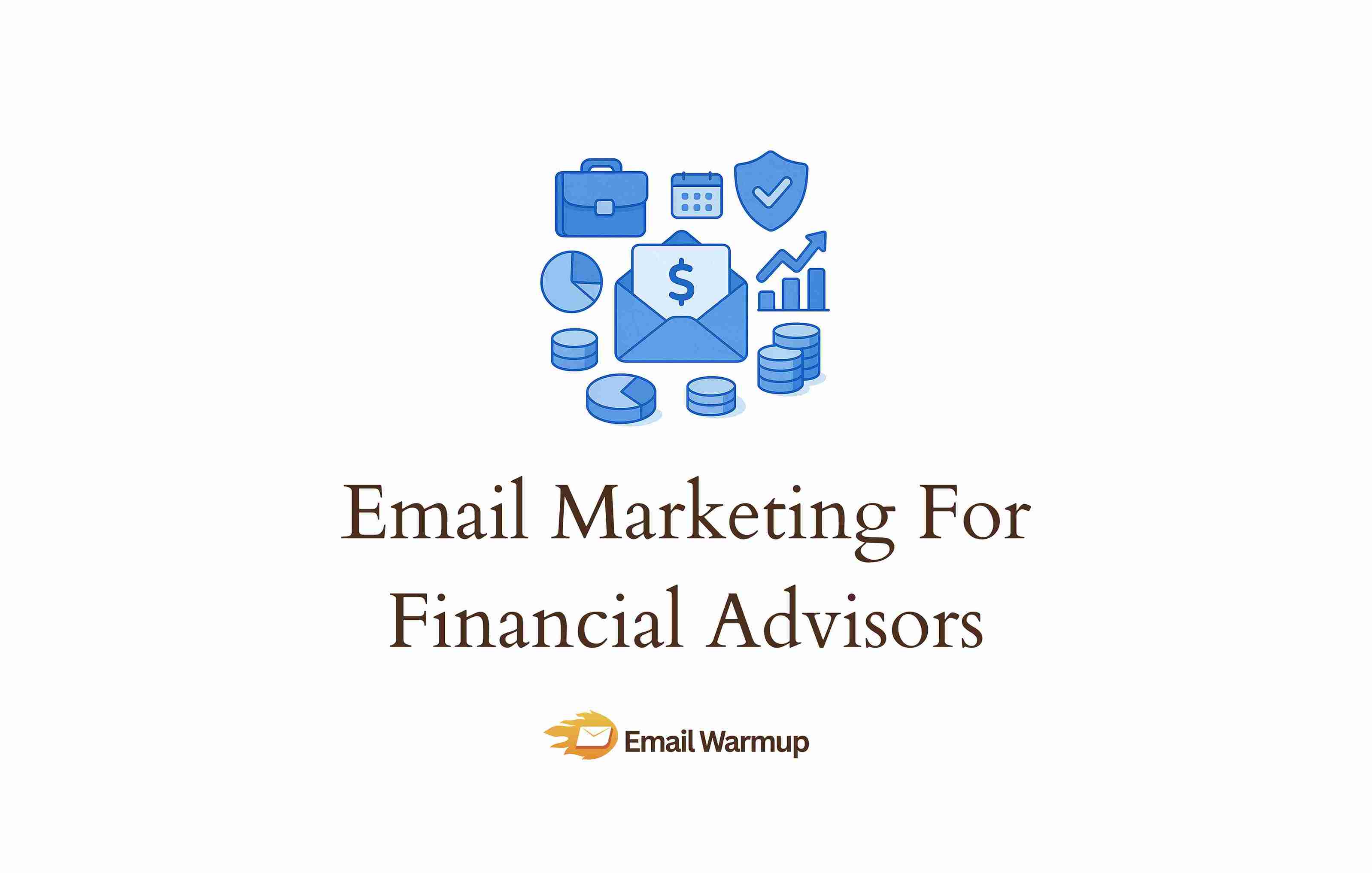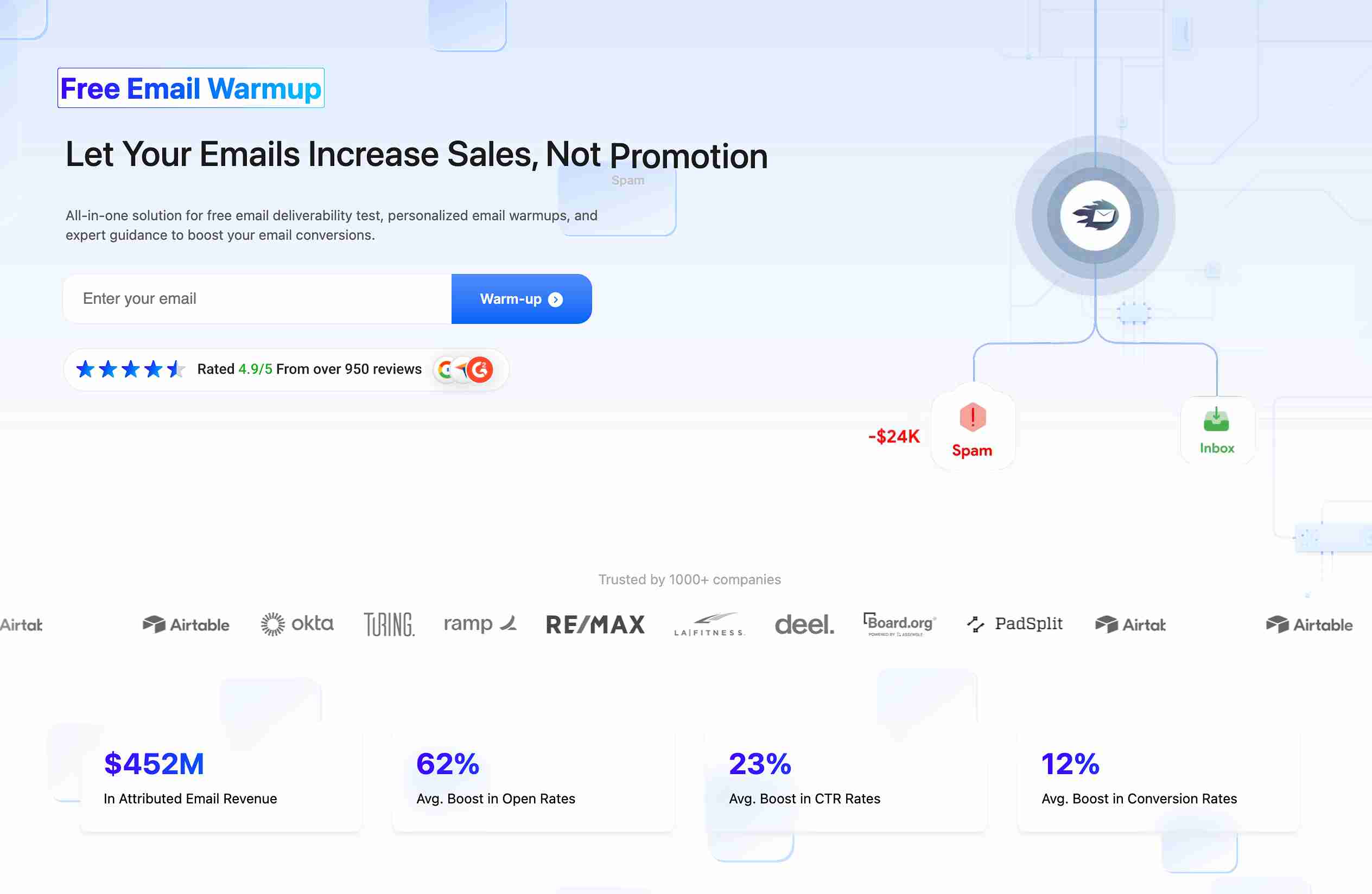
As a financial advisor, you’re compliant with the SEC and FINRA when it comes to your emails. You personalize and provide value, ensuring you connect with your clients on both a professional and emotional level.
Yet Zeta Global’s Q4 2024 benchmark shows your 8% open rate falls far below the financial services average of 18-22%.
As an email marketing consultant who has worked with financial services firms to execute perfect campaigns, I’ve prepared this guide covering email marketing for financial advisors from a 365° angle.
Let’s help you build an email strategy that drives results.
TLDR: Email marketing for financial advisors in a nutshell
Don’t have the time to go through the entire piece? Here’s a list of campaigns, frequency, and purpose for each — to help you execute powerful email marketing campaigns in the financial niche:
| Campaign type | Frequency | Purpose |
| Client onboarding | One-time (7 emails, 30 days) | Build trust with new clients |
| Market commentary | Monthly | Position as thought leader |
| Tax planning reminders | Quarterly | Trigger deadline conversations |
| Portfolio reviews | Quarterly | Maintain engagement |
| Educational series | Weekly or bi-weekly | Demonstrate expertise |
| Referral requests | Twice yearly | Generate new business |
| Milestone emails | Triggered | Personalize relationships |
Your emails need to reach inboxes first
Financial advisors face unique scrutiny. Phishing attacks constantly impersonate advisors, so providers flag anything suspicious. According to Google’s sender guidelines, missing authentication or high complaint rates will block your mail regardless of content quality.

EmailWarmup.com solves this by offering:
- Unlimited email testing before campaigns launch
- Real-time spam checker showing exactly where emails land
- Personalized email warmup mirroring your style and sending patterns
- Access to email deliverability consultants who understand financial compliance
We set everything up immediately. Want us to show you how?
Schedule your consultation call
What email campaigns convert for financial advisors?
Generic newsletters don’t work. Clients need targeted messages for their situation and timing.
1. Client onboarding sequences
New clients are anxious about their choice. Send seven emails over 30 days:
- Explain your process
- Introduce your team
- Set communication expectations
- Provide needed resources
This reduces no-shows and increases referrals because clients feel supported immediately.
2. Market commentary newsletters
When markets drop 3% in a day, clients panic. Monthly newsletters explaining what’s happening (without predicting futures or making performance claims) keep you top-of-mind.
Write about macroeconomic trends, policy changes, or sector rotation — anything helping clients understand volatility without violating regulations.
3. Tax planning reminders
Send emails in March, June, September, and December about:
- Roth conversions
- Capital gains harvesting
- Required minimum distributions
These aren’t sales emails — they trigger high-value conversations naturally.
4. Quarterly portfolio reviews
Don’t wait for clients to reach out. Proactively invite them to review progress, rebalance allocations, or adjust goals. Clients engaging quarterly have significantly lower attrition than those contacted annually.
5. Educational content series
Pick one topic (retirement income planning, estate tax changes, Medicare enrollment). Send weekly or bi-weekly emails covering different aspects. According to McKinsey’s research on personalization, targeted educational content drives a 10-15% revenue lift when properly segmented.
6. Referral request campaigns
Most advisors ask awkwardly during meetings. Send an email twice yearly to satisfied clients explaining that you have the capacity for new relationships. Make forwarding easy. Time these after positive interactions like strong portfolio performance or successful planning conversations.
7. Birthday and milestone emails
Automated emails on birthdays, work anniversaries, or retirement dates show you’re thinking about clients as people. Simple messages build goodwill extending beyond financial discussions.
How do you write SEC and FINRA-compliant emails?
Compliance doesn’t mean boring — it means accurate.
Where disclosures belong
The SEC Marketing Rule (Rule 206(4)-1) requires specific disclosures. Include firm name, address, and registration information in email footers. Add past performance and forward-looking statement language if relevant. Grouping disclosures together prevents disruption to message flow.
Testimonial restrictions
You can’t cherry-pick positive feedback without proper disclosures. Referencing client satisfaction or results requires context about how information was gathered and whether it’s representative. Most advisors avoid testimonials in email because disclosure requirements make them impractical.

Performance claim formatting
Never mention returns without showing net-of-fee performance, appropriate time periods, and relevant benchmarks. Even saying “we helped clients navigate the 2024 market” implies superior performance. Stick to factual statements about services provided rather than results achieved.
Archiving requirements
FINRA guidance on books and records requires capturing and storing every message for regulatory examinations (drafts, A/B tests, personalized variations). Most advisors use platforms with built-in archiving or integrate email systems with compliance software.
Supervised person review
If you’re not a principal at your firm, emails likely need approval before sending. Build this into the workflow by creating pre-approved templates, reducing friction for regular communications.
What’s the right email frequency?
More emails don’t mean more engagement. Timing matters more than volume.
| Audience | Frequency | Content focus |
| Prospects | Weekly for 90 days | Educational content, insights |
| New clients | 2-3x weekly for 30 days | Onboarding, expectations |
| Established clients | Monthly newsletter + quarterly invites | Market commentary, reviews |
| Life-stage triggers | Immediate | Age-specific decisions |
| Market events | Within 24 hours | Calming reassurance |
The biggest mistake is emailing only when you need something. If every email requests meetings or referrals, clients tune out. Maintain a ratio of five value-focused emails for every request.
How should you segment your email lists?
Sending identical messages to everyone leaves money on the table.
Assets under management
McKinsey’s research shows personalized segmentation drives measurable lift. Therefore, you must create tiers that help you sort the message you want to convey with your emails:
- Under $250k requires broad educational content
- $250k-$1M requires retirement planning focus
- $1M-$5M requires tax optimization strategies
- $5M+ requires estate planning, trust structures
Life stage segments
You can also break that down based on the ages (life stage) of your clients:
| Life Stage | Age Range | Primary Topics | Best Content Types |
| Building & College Planning | 35–45 | Wealth accumulation, 529 plans, risk management | Step-by-step guides, contribution calculators, “how much to save” worksheets, checklists, ROI scenario charts, short explainer videos, email drip lessons, FAQ pages |
| Pre-Retirement Readiness | 46–59 | Retirement income planning, catch-up contributions, asset allocation, tax efficiency | Retirement readiness checklists, gap analyzers, interactive calculators, portfolio rebalancing guides, webinars/Q&A, case studies, comparison tables |
| Early Retirement/Enrollment | 60–73 | Distribution strategies, Medicare enrollment/coverage choices, tax-smart withdrawals | Decision trees, Medicare comparison sheets, withdrawal strategy playbooks, tax-bracket maps, live workshops, step-by-step timelines, “mistakes to avoid” one-pagers |
| Post-RMD & Legacy | 73+ | RMDs compliance, charitable giving, estate/legacy planning | RMD calendar & calculator, beneficiary checklists, estate planning guides, gifting strategies sheets, trust/POA explainer videos, reminder emails & alerts |
Service type groups
Retirement planning clients need different content than estate strategy or tax optimization clients. Segmenting by service type enables cross-selling without pushiness.
Engagement level
Some clients read every email. Others haven’t opened messages in six months. Create segments to divide your list by engagement levels:
- Opened email in the last 30 days
- Clicked link in the last 60 days
- Zero activity in 90+ days
Re-engagement campaigns win back dormant clients. Highly engaged clients are ready for referral requests.
What metrics should you track?
Open rates matter, but they don’t pay overhead.
Open rates indicate subject line effectiveness
Financial services should achieve 18-22% according to Zeta Global’s Q4 2024 benchmark. Below 15%? Your subject lines need work, or your deliverability is broken. Don’t chase rates above 30% — that usually means emailing too infrequently or only to highly engaged clients.
Click-through rates reveal content quality
When 5-8% of recipients click links, your content resonates. Lower than 3%? Calls-to-action are weak, or the content doesn’t match the audience’s needs. Track which topics (tax planning, market commentary, retirement strategies) generate the most clicks.

Meeting bookings measure direct impact
Tag meetings that came from email with source codes. How many quarterly review invitations turned into appointments? How many prospects scheduled introductory calls after the educational series? These conversions tie email directly to a revenue opportunity.
AUM growth attributed to email
When clients add assets or prospects convert, ask what prompted the action. Was it a specific email? Over time, patterns emerge about which campaigns drive asset gathering. Track manually if your CRM doesn’t automate this.
Spam complaint rates
According to Google’s sender FAQ, spam complaints should stay below 0.1%. Above 0.3%, providers throttle delivery aggressively. Our email spam checker shows real-time flagging, letting you catch problems before they damage the sender’s reputation.
The metric that matters most is the revenue per email subscriber. Calculate total AUM or annual revenue from clients receiving emails, divided by list size. This reveals whether email marketing grows your business or just keeps you busy.
What are the biggest mistakes financial advisors make in email marketing campaigns?
Fixing a damaged sender reputation takes months. Avoid these mistakes.
Treating prospects like clients
Prospects don’t want portfolio review invitations. Clients don’t need introductory service explanations. Sending identical emails to everyone makes both groups ignore messages.
Ignoring deliverability until it’s too late
You discover spam placement when someone mentions not hearing from you. By then, reputation is damaged. Recovery takes 60-90 days of careful warmup and consistency. Check deliverability proactively.
Stopping at first-name personalization
Most advisors use mail merge for names and call it personalization. Real personalization references recent conversations, acknowledges specific goals, or ties content to individual circumstances. Segment by life stage or service type and write targeted content for each group.

Emailing only when asking for something
If every email requests meetings, referrals, or service pitches, audiences learn to delete without reading. Build value first through educational content and market insights. Then, ask for attention.
Skipping follow-up sequences
Someone downloads your retirement guide but never responds. Most advisors send one follow-up (maybe) and move on. Proper sequences send five to seven emails over 45 days, each addressing different retirement planning aspects. Respectful persistence converts prospects’ single emails missed.
Buying email lists
Purchasing “high net worth individual” lists violates regulations and destroys reputation. Purchased lists have terrible deliverability because recipients don’t know you. Providers see mass sending to unengaged recipients and flag you immediately.
Using shared hosting platforms
Sending through shared IP addresses inherits everyone else’s reputation. If another user gets flagged for spam, your emails suffer. Financial advisors should use reputable platforms or dedicated IPs that control sender reputation.
How do you build permission-based email lists?
Quality relationships matter more than list size — that’s the entire essence of email marketing for financial advisors.
Website opt-in forms
Add email signup to the homepage, blog posts, and resources pages. Offer something specific:
- Retirement planning checklist
- Market commentary subscription
- Tax planning guide
Specific offers attract more qualified subscribers than generic “subscribe to newsletter” requests.
Client referrals come with trust
When satisfied clients introduce you to network contacts, ask if you can add them to your list for educational content. Most referrals agree because they trust the referrer. This beats cold outreach since recipients expect to hear from you.
Event sign-ups double as list building
Host retirement planning workshops or market outlook webinars. Everyone registering provides email and permission. Follow up with attendees (and no-shows) to continue conversations and move them toward becoming clients.
Content downloads qualify prospects
Create valuable resources (comprehensive retirement planning guide, estate planning checklist, tax optimization workbook) and gate them behind email forms. Downloads demonstrate interest in specific topics, giving natural segmentation and follow-up reasons.
LinkedIn conversations transition to email
When LinkedIn connections produce productive conversations, suggest continuing via email, where you can share detailed resources. This feels natural rather than aggressive, giving permission to add them to targeted campaigns.
Focus on growing lists with people who care about what you say. According to Litmus research on email ROI, quality beats quantity — 200 engaged prospects and clients outperform 2,000 random contacts.
Why do financial advisor emails land in spam?
You send retirement planning advice. Clients never see it. Three days later, they ask why you haven’t been in touch.
Authentication gaps destroy credibility
Google’s email sender guidelines require SPF, DKIM, and DMARC records. Financial phishing is rampant. Providers can’t verify unverified senders, so they route your mail to junk automatically.
Compliance language triggers pattern recognition
Validity’s 2025 Email Deliverability Benchmark Report found that certain promotional financial phrases combined with missing authentication create spam flags. So if your disclaimer about past performance not guaranteeing future results, filters see similar wording in scam emails. You’re being compliant, but algorithms can’t distinguish you from fraudsters.

Cold sending from new domains gets blocked
If you started a new RIA or changed firm names, your domain has zero reputation. Sending 50 emails on day one makes you look like a spammer. Providers block immediately.
Generic subject lines compete with noise
“Market Update – October 2025” competes with thousands of identical subjects. Providers downgrade delivery when your emails look indistinguishable from mass marketing.
Test your actual deliverability using our email deliverability test — most advisors discover they’re only hitting inboxes 30-40% of the time.
What inbox placement changes for email marketing in 2025?
Validity’s 2025 Email Deliverability Benchmark Report revealed inbox placement dropped significantly in 2024 across industries. Financial services face additional pressure from phishing concerns. Providers now prioritize:
- Gradual sending ramps
- Engagement-based reputation
- Low complaint rates (below 0.1%)
- Authenticated senders (SPF, DKIM, DMARC, BIMI)
The difference between 40% and 98% inbox placement is not writing talent or marketing budget. It’s whether messages reach inboxes. Advisors fixing deliverability first see open rates jump from 8% to 20%+ immediately. The same emails that were invisible suddenly generate responses.
- What if your clients actually received your emails?
- What if prospects read educational content and booked meetings?
- What if email became your most reliable AUM source instead of your most frustrating marketing channel?
That transformation starts with deliverability. Fix it first, and everything else follows. If you need help in doing that:
Frequently asked questions about email marketing for financial advisors
Here are some commonly asked questions about email marketing for financial advisors:
Yes, with proper supervision and archiving. Set up sequences for onboarding, education, or nurture campaigns after compliance reviews of content. Your platform must capture and store all automated sends for regulatory examinations. Automated doesn’t mean impersonal — write sequences sounding like one-on-one conversations, just scheduled in advance.
Not necessarily, but many find it helpful for tracking. Using “insights@yourfirm.com” for newsletters and “yourname@yourfirm.com” for client communication lets you segment sender reputation. Both addresses need proper authentication and warmup. A fresh marketing email with no sending history lands in spam regardless of content.
Between 200 and 400 words for newsletters and educational content. Shorter than 200 feels incomplete. Longer than 400 loses attention. Client-specific emails (responding to questions, following up on meetings) should be brief and helpful. Portfolio review invitations can be three sentences. Market commentary newsletters can run 350 words. Match length to purpose.
Plain text for personal communication, simple HTML for newsletters. When emailing individual clients, plain text feels authentic and has better deliverability. For monthly newsletters or educational campaigns, use light HTML with minimal images and simple formatting. Avoid heavy designs or complex layouts — they trigger spam filters and load slowly.
Choose platforms offering built-in compliance archiving or seamless integration with compliance software. Mailchimp and Constant Contact work for small practices with simple needs. Redtail, Wealthbox, and Riskalyze integrate with advisor-specific CRMs and include compliance features. Enterprise RIAs often use HubSpot or Marketo with dedicated compliance add-ons. Archiving capability is non-negotiable.
Include unsubscribe links in every marketing email (required by CAN-SPAM) and honor requests immediately. Don’t keep people on lists who want off — it damages deliverability and violates regulations. However, segment unsubscribes rather than being removed entirely. Someone might unsubscribe from weekly market updates but still want quarterly tax planning reminders. Give granular control over what they receive.
Generally no, but context matters. If someone requests information through your website, you have implied permission for follow-up. If you met at a networking event and exchanged cards, a single introductory email is usually acceptable (with no further contact if they don’t respond). Purchasing lists or scraping LinkedIn crosses legal and regulatory lines. Default to permission-based marketing — it’s better for deliverability and compliance.
References
- Baer, J. (2013). Youtility: Why smart marketing is about help not hype. Portfolio.
- Cialdini, R. (2006). Influence: The psychology of persuasion (Revised ed.). HarperCollins.
- Godin, S. (1999). Permission marketing: Turning strangers into friends and friends into customers. Simon & Schuster.
- Google. (2025). Email sender guidelines. Google Workspace Admin Help.
- FINRA. (2025). Books and records guidance. FINRA.org.
- Kahneman, D. (2011). Thinking, fast and slow. Farrar, Straus and Giroux.
- Klaviyo. (2025). 2025 email marketing benchmarks by industry. Klaviyo Products.
- Litmus. (2025). The ROI of email marketing. Litmus Blog.
- Litmus. (2025). The 2025 marketer’s guide to email deliverability. Litmus Blog.
- McKinsey & Company. (2021, November 12). The value of getting personalization right — or wrong — is multiplying. McKinsey Insights.
- SEC. (2020). Investment adviser marketing (Rule 206(4)-1). SEC.gov.
- Validity. (2025). 2025 email deliverability benchmark report. Validity Resource Center.
- Zeta Global. (2024). Q4 2024 email benchmark report: Financial services. Zeta Global.



